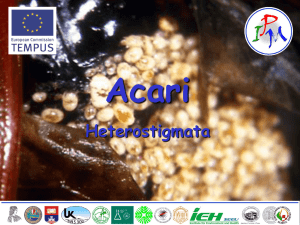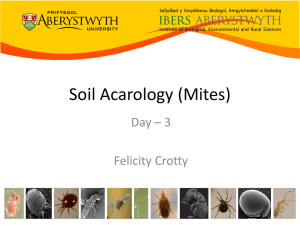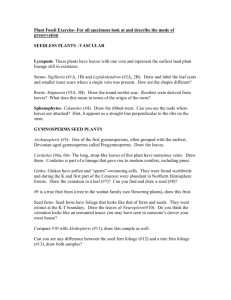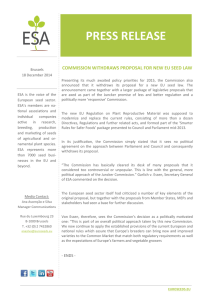Registered chemicals for crops during autumn and winter 2015
advertisement
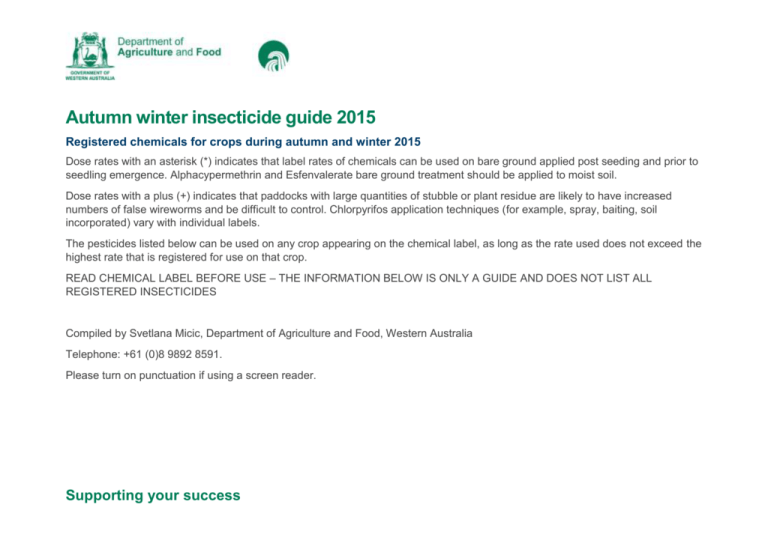
Autumn winter insecticide guide 2015 Registered chemicals for crops during autumn and winter 2015 Dose rates with an asterisk (*) indicates that label rates of chemicals can be used on bare ground applied post seeding and prior to seedling emergence. Alphacypermethrin and Esfenvalerate bare ground treatment should be applied to moist soil. Dose rates with a plus (+) indicates that paddocks with large quantities of stubble or plant residue are likely to have increased numbers of false wireworms and be difficult to control. Chlorpyrifos application techniques (for example, spray, baiting, soil incorporated) vary with individual labels. The pesticides listed below can be used on any crop appearing on the chemical label, as long as the rate used does not exceed the highest rate that is registered for use on that crop. READ CHEMICAL LABEL BEFORE USE – THE INFORMATION BELOW IS ONLY A GUIDE AND DOES NOT LIST ALL REGISTERED INSECTICIDES Compiled by Svetlana Micic, Department of Agriculture and Food, Western Australia Telephone: +61 (0)8 9892 8591. Please turn on punctuation if using a screen reader. Supporting your success Contents Registered chemicals for crops during autumn and winter 2015 ......................................................................................................1 Control of canola seedling pests .......................................................................................................................................................3 Blue oat mite .................................................................................................................................................................................4 Slugs and snails ............................................................................................................................................................................4 Control of lupin and some grain legume seedling pests ...................................................................................................................5 Control of cereal seedling pests .......................................................................................................................................................6 Balaustium mite.............................................................................................................................................................................7 Blue oat mite .................................................................................................................................................................................7 Pesticide active ingredient and equivalent trade names ...................................................................................................................8 Important disclaimer .........................................................................................................................................................................9 Control of canola seedling pests Alphacypermethrin 100g/L Beta-cyfluthrin 25g/L Bifenthrin 100g/L Chlorpyrifos 500g/L and Bifenthrin 20g/L Chlorpyrifos 500g/L Cypermethrin 200g/L Delta-methrin 27.5g/L Dimethoate 400g/L Esfen-valerate 50 g/L Gammacyhalothrin 150 g/L Lambdacyhalothin 250 g/L Maldison 1150 g/L Methidathion 400g/L Omethoate 290g/L Table 1 Registered chemicals for canola and oilseed crops during autumn and winter 2015 (Chemical active ingredient names are listed. Rates are given as millilitres per hectare (mL/ha) unless specified otherwise. g/L refers to grams per litre. N/A refers to Not applicable) Balaustium mite Bryobia mite ! N/A N/A 1000 N/A N/A N/A N/A N/A N/A N/A N/A N/A N/A N/A N/A 200* 1000 N/A N/A N/A N/A N/A N/A N/A N/A N/A 120 Redlegged earth mite 50*– 100* 200 50*– 100* 50– 75 40– 85 9 N/A 200* 100 N/A N/A N/A 250–500 N/A N/A N/A N/A 100 400 n/a N/A N/A N/A N/A N/A 700– N/A 900 200 N/A 400– 500 70 N/A 10–15 12–18 N/A N/A N/A Brown pasture looper N/A 200 – 400 N/A 500– 1000 875– 1000 N/A 75 100– 200 200 160– 340 N/A 200* Vegetable weevil Cutworm 40– 85 N/A 50– 70, 100* n/a 8 Lucerne flea 140* – 300* N/A N/A 250–500 50*– 100* 250–500 N/A N/A 70 10 n/a N/A N/A N/A False wire worm N/A N/A N/A 625– 1000 1 or 1.5 L/ha N/A 500 or N/A 2.5L/ha of ULV formulation N/A N/A N/A N/A N/A N/A N/A N/A 500 N/A 30 36 1.25 L/ha N/A N/A No data + Rutherglen bug 250– 400 N/A N/A N/A N/A 380– 500 N/A ! Rates of alphacypermethrin that are used against weevils have been effective on balaustium mite. Rates of bifenthrin used for bryobia mite have given poor kill of balaustium mite. Table 2 Seed dressing application for control of redlegged earth mite (RLEM) and lucerne flea in canola (refer to labels for dilution rate) No data Fipronil 500g/L Imidacloprid 600g/L Dimethoate 400g/L Fipronil 500g/L Redlegged earth mite 400mL/1000kg seed 400mL/100kg 330mL/100kg seed 400mL/1000kg seed Lucerne flea 150mL/100kg seed N/A N/A N/A Table 3 Seed dressing application for suppression of redlegged earth mite (RLEM) and lucerne flea in canola (refer to labels for dilution rate) No data Thiamethoxam (210g/L) + Lambda-cyhalothrin (37.5g/L) Redlegged earth mite and lucerne flea 1000mL/100kg seed Blue oat mite Generally a minor pest in Western Australia and mostly controlled with chemical and rates used against redlegged earth mite. Mite samples can be sent to Entomology, Department of Agriculture and Food, Western Australia for free identification. Slugs and snails For best results broadcast baits evenly over the paddock before crop emergence. A better kill rate is achieved when there is little green plant material to compete with the baits to attract slugs/snails. Trials have shown that a baiting rate of 5kg/ha is sufficient in most cases. However, if numbers are high use the highest baiting rate. Baits may need to be reapplied. Rainfast baits will persist longer in the paddock. Three bait types are available: 1. Metadehyde: 50 grams per kilogram (g/kg) active ingredient (a.i). Baiting rate 5-7.5kg/ha. 2. Methiocarb: 20g/kg a.i. Baiting rate 5.5-22kg/ha. 3. Iron EDTA: 60g/kg a.i. Baiting rate 5-16kg/ha. Control of lupin and some grain legume seedling pests Alphacypermethrin 100g/L Beta-cyfluthrin 25g/L Bifenthrin 100g/L Chlorpyrifos 500g/L and Bifenthrin 20g/L Chlorpyrifos 500g/L Cypermethrin 200g/L Delta-methrin 27.5g/L Dimethoate 400g/L Esfen-valerate 50 g/L Gammacyhalothrin 150 g/L Lambdacyhalothin 250 g/L Maldison 1150 g/L Methidathion 400g/L Omethoate 290g/L Table 4 Registered chemicals for lupin and some grain legume crops during autumn and winter 2015 (Chemical active ingredient names are listed. Rates are given as millilitres per hectare (mL/ha) unless specified otherwise. g/L refers to grams per litre. N/A refers to Not applicable) Bryobia mite N/A N/A 200* N/A N/A N/A N/A N/A N/A N/A N/A N/A 120 N/A Redlegged earth mite 50–100 * 200 50* – 100* 250–500 N/A N/A 90 100 50– 100 * N/A N/A 250–500 N/A N/A 50– 70, 100* N/A 9 N/A N/A N/A 90 100 N/A Cutworm 75 200 – 400 N/A N/A N/A 75 75m L/10 0L 85m L/10 0L N/A 8 Lucerne flea 140* – 300* N/A 70 N/A N/A N/A N/A 75 Brown pasture looper N/A N/A 50*– 100* 250-500 N/A N/A 200 or 1L/ha of ULV formulation 500 or 2.5 N/A L/ha of ULV formulation 35 10 12 N/A N/A N/A No data Table 5 Seed dressing application for control of redlegged earth mite (RLEM) and lucerne flea in lupin (refer to labels for dilution rate) No data Imidacloprid 600g/L Dimethoate 400g/L Redlegged earth mite 300mL/100kg 150mL/100kg seed Lucerne flea 150mL/100kg seed N/A Control of cereal seedling pests A synthetic pyrethroid top-up spray is recommended to be applied 7-8 weeks after sowing Imidacloprid treated seed for control of aphids vectoring barley yellow dwarf virus (BYDV). 700–900 75 200 Desiantha larvae N/A N/A N/A N/A N/A Lucerne flea N/A N/A N/A Redlegged earth mite Webworm 50– 100* 75 200 50*– 100* 100 250– 500 250– 500 500 Seed dressing: see Table 9 70 140 100– 200 300 Omethoate 290g/L N/A Methidathion 400g/L N/A Maldison 1150 g/L feeding damage only 500 Lambdacyhalothin 250 g/L Delta-methrin 27.5g/L N/A Gammacyhalothrin 150 g/L Cypermethrin 200g/L N/A Esfen-valerate 50 g/L Chlorpyrifos 500g/L N/A 125 antifeed Dimethoate 400g/L Chlorpyrifos 500g/L and Bifenthrin 20g/L N/A Aphids (including BYDV control) Cutworm Beta-cyfluthrin 25g/L N/A 75 250 or 500 antifeed N/A No data Alphacypermethrin 100g/L Bifenthrin 100g/L Table 6 Registered chemicals for cereal crops during autumn and winter 2015 (Chemical active ingredient names are listed. Rates are given as millilitres per hectare (mL/ha) unless specified otherwise. g/L refers to grams per litre. N/A refers to Not applicable) 10 – 15 antifeed N/A N/A N/A N/A N/A 25 N/A 12 or 18 antifeed 12 or 18 N/A N/A N/A N/A N/A N/A N/A 100 N/A 50–70 100* 70 8 9 100 N/A 10 12 90– 200* 90– 200* n/a n/a 50 N/A 100 – 300 antifeed 70 N/A N/A N/A N/A N/A 55–85 50– 75 75 N/A 55–85 200 N/A 10-15 Table 7 Seed dressing application for control of aphids in cereals (refer to labels for dilution rate) No data Imidacloprid 600g/L Thiamethoxam (210g/L) + Lambda-cyhalothrin (37.5g/L) Aphids (including BYDV control) Aphids for feeding damage 120 or 240mL/100kg seed (higher rate for increased length of control in high risk areas) N/A N/A 165–330L/100kg seed (higher rate in areas where higher pest pressure is expected or longer period of control required Table 8 Seed dressing application for suppression of redlegged earth mite (RLEM) and lucerne flea in cereals (refer to labels for dilution rate) No data Thiamethoxam (210g/L) + Lambda-cyhalothrin (37.5g/L) Redlegged earth mite and lucerne flea 330mL/100kg seed Table 9 Seed dressing application for control of desiantha larvae in cereals (refer to labels for dilution rate) No data Chlorpyrifos (500g/L) Desiantha larvae 120mL/100kg seed Balaustium mite No chemicals currently registered. Rates of Alphacypermethrin that are used against weevils have been effective on balaustium mite. Rates of Bifenthrin used for bryobia mite have given poor kill of balaustium mite. Blue oat mite Generally a minor pest in Western Australia and mostly controlled with chemical and rates used against redlegged earth mite. Mite samples can be sent to Entomology, Department of Agriculture and Food, Western Australia for free identification. Pesticide active ingredient and equivalent trade names Table 10 Pesticide active ingredient and equivalent trade names Insecticide group Chemical names Trade names (list may not be complete - check with your retailer) 1A Carbamates Pirimicarb 1B Organophosphates chlorpyrifos 500 g/L 1B Organophosphates dimethoate 400 g/L 1B Organophosphates maldison 1150 g/L Atlas, Aphidex 500, Piricarb WG, Piri-Ken, Pirimicarb 500, Pirimidex, Pirimor WG Chlorpyrifos, Chemicide, Chlorban, Chlorpos, Chlorpyrifos 500, Chop 500, Cutter, Cyren 500, Cuft, Fortune 500, Generifos 500, Pest Controller, Kensban, Lorsban 500, Strike-Out, Pyrinex (also contains group 3A bifenthrin 20g/L) Danadim, Dimetholinx, Dimethoate, Dimethoate 400, Dimethoate Insecticide, Rover, Saboteur, Stalk Hy-Mal 1B Organophosphates methidathion 400 g/L Suprathion 400EC 1B Organophosphates omethoate 290 g/L 1B Organophosphates Phosmet All-Mitey 290 SL, Le-mat 290 SL, Mite Master, Omen 290, Omethoate 290 SL, Ometho-Mite, Ovid Imidan 2B Phenylpryazoles (Fiproles) fipronil 500 g/L Cosmos seed dressing 3A Pyrethroids Pyrethrins alphacypermethrin 100 g/L 3A Pyrethroids Pyrethrins beta-cyfluthrin 25g/L Alf, Alpha100, Alpha Cyper, Alpha-Cyp100 Duo, Alpha-cypermethrin 100, Alpha Duo, Alpha Duo 100, Alpha Duop 100, Alpha-Scud Elite, Alphasip Duo, Astound Duo, Buzzard, Centaur 100, Dictate 100, Dominex Duo, Fastac Duo, Ken-Tac 100, Mascot Duo, Unialphacyper 100, Unichoice100 Bulldock Duo 3A Pyrethroids Pyrethrins bifenthrin 100 g/L 3A Pyrethroids Pyrethrins bifenthrin 250 g/L Agfen, Arrow, Astral, Beast, Bifenthrin, Bifendoff, Bisect, Compel, Disect, Fenstar, Killzone, Out Of Bounds, Sarritor, Surefire Bent, Talstar, Tal-Ken, Venom, Zeus, Pyrinex (bifenthrin 20g/L & also contains group 1B chlorpyrifos 500g/L) Astral 250, Bifenthrin 250, Stockade, Talstar 250 3A Pyrethroids Pyrethrins cypermethrin 200 g/L Boom 200, Cypermethrin 200, Cypershield 200, Cyrux 200, Scud Elite 3A Pyrethroids Pyrethrins cypermethrin 250 g/L Arrivo 250, Cyperplus 250, Cypermethrin 250, Cyrux 250 3A Pyrethroids Pyrethrins cypermethrin 260 g/L Cypermethrin 260 Insecticide group Chemical names Trade names (list may not be complete - check with your retailer) 3A Pyrethroids Pyrethrins deltamethrin 27.5 g/L 3A Pyrethroids Pyrethrins esfenvalerate 50 g/L Ballistic-Elite, D-Sect, Decis Options, Delta Duo, Deltamethrin Duo, Delta Shield, Dicast Sumi-Alpha Flex Insecticide. 3A Pyrethroids Pyrethrins gamma-cyhalothrin 150 g/L Trojan 3A Pyrethroids Pyrethrins lambda-cyhalothrin 250g/L 3A Pyrethroids Pyrethrins lambda-cyhalothrin 37.5g/L Cyhella, Flipper, Karate Zeon Tech, Kung Fu, Lambda, Lamdacyhalothrin, Matador with Zeon Tech Cruiser Opti seed dressing (also contains Group 4A thiamethoxam) 3A Pyrethroids Pyrethrins permethrin 40:60, 500g/L Ambush, Axe, Pounce, Hellfire, Permethrin, Permekil, Permerid, Stakeout 4A Neo-nicotinoids imidacloprid 600 g/L 4A Neo-nicotinoids imidacloprid 180 g/L 4A Neo-nicotinoids thiamethoxam 210g/L 4C Sulfoxaflor sulfoxaflor Confederate, Emerge, Gaucho, Genero, Guardian, Immi 600, Impressor 600, Imida 600, Imidacloprid 600, Inflict 600, Nuprid, Picus, Protectaflo, Savage 600, Senator 600, Imi- Flow, Zooter 600 (seed dressings) Arrow Plus, Foliarflo Plus, Hombre, Imid- Triadimenol, Protectaflo, ProLeaf, ProGuard, Tri Power, Veteran Plus, Zorro (seed dressings) Cruiser Opti seed dressing (also contains Group 3A lambda-cyhalothrin 37.5g/L) Transform 11 Bacillus thuringiensis (insecticidal proteins) Bt (k) Bacchus WG, Biocrystal, Delfin WG, Dipel SC, Dipel DF, Xentari WG Important disclaimer The Chief Executive Officer of the Department of Agriculture and Food and the State of Western Australia accept no liability whatsoever by reason of negligence or otherwise arising from the use or release of this information or any part of it. Copyright © Western Australian Agriculture Authority, 2015

